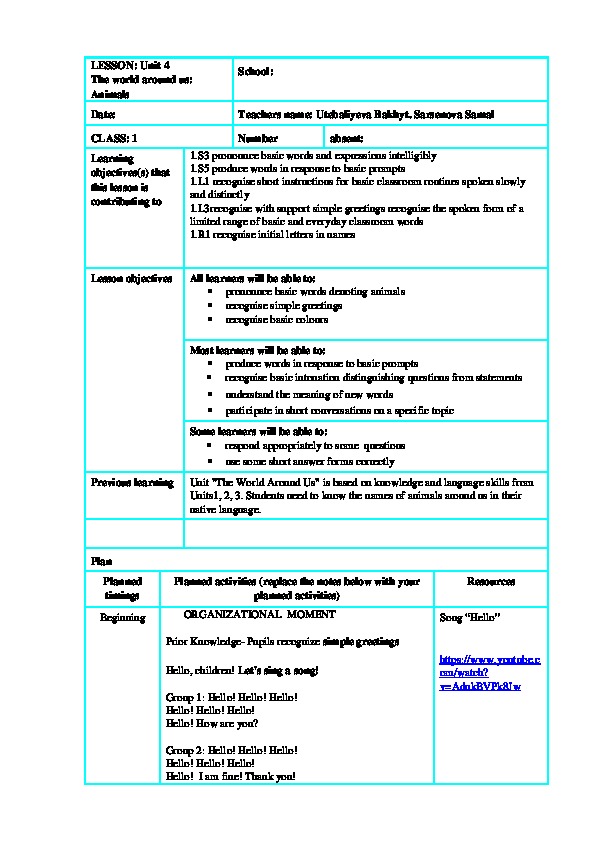План урока animals 1 класс
Обновлено: 06.07.2024
Открытый урок потеме Animals. С повторение лексики цифры, цвета.
Содержимое разработки
Открытый урок по английскому языку в 1 классе
Учитель: Паршукова М.Г.
Цели урока:Общеобразовательная: Способствовать развитию навыков говорения, использовать изученный лексически материал в различных речевых ситуациях.
Развивающая: Способствовать развитию коммуникативной компетенции учащихся путем вовлечения их в активную речевую деятельность, развитие познавательной активности учащихся, внимания, памяти, логического мышления.
Воспитательная: Прививать интерес к изучению английского языка, формировать положительную мотивацию и устойчивый интерес.
-обучающая: систематизировать употребление глаголов действия, тренировать употребление названий школьных предметов; научиться употреблять в речи глагол must
-развивающие: совершенствовать навык аудирования; развивать умения и навыки устной монологической и диалогической речи на основе изученного материала.
-воспитательные: формировать положительную мотивацию и устойчивый интерес к изучению английского языка.
Main aim: Practice of speaking skills
Subsidiary aim: readings practice
Language : animals : rabbit, fish, cat, dog, mouse, big ,little, tall, tiger, monkey, elephant, colours

I introduce you with animals by video and learners should repeat after the speaker. I’ll divide you into two groups “Wild animals group” and “Domestic animals group” with pictures of animals under the chair
To give the pupils “concept’ and “convergent” questions
-What is it?
-A learner names animals and answers the questions them.
Now, lets play the game “Slowly-slowly”
- I show the pictures slowly and you should find what can you see in the picture.



A learner guesses the hidden picture according to the animals.
CREATIVE WORK
I’ll give out everybody worksheets with the pictures of animals and you should paint them.

-A learner paints each animals with their typical colours.
Energizer “Creativе dance of animals”
Task4 WORKING WITH CARDS
1) You should match the animals with habitats or places where they live. Group work. I’ll give you two papers and you should stick the pictures dividing into two groups. Domestic animals which live in the farms near the people and wild animals which live in the forest.
-A learner chooses the wild animals and the domestic animals
Task 5 listen and guess
-Now listen the sounds of animals and birds and you should guess what animal is it.
-A learner guesses and names the animals by listening their sounds
Worksheets of animals
Pupils produce words in response to basic prompts.
Show your mood
happy like a monkey
sad like a wolf
energetic as a lion
Additional information
Differentiation – how do you plan to give more support? How do you plan to challenge the more able learners?
Assessment – how are you planning to check learners’ learning?
Cross-curricular links
Health and safety check
ICT links
Values links
more support can be given during elicitation, instruction and questioning phases of the lesson by nominating learners to answer items relating to more high frequency vocabulary to build confidence through participation.
more able learners will be challenged by prompting their groups to develop more elaborate types of animals to narrate.
through questioning and the redirecting of questioning in feedback activities

Бесплатное участие. Свидетельство СМИ сразу.
До 500 000 руб. ежемесячно и 10 документов.
План урока по английскому языку на тему "Animals" по учебнику Smiles 1 по обновленной программе для учеников 1 класса содержит интересные задания с учетом возрастных особенностей детей, которые способствуют повышению интереса учеников изучать иностранный язык. Дети учатся работать в парах и в группах.разработка урока по английскому языку 1 класс Smiles 1

To revise the names of animals pupils play different games.

Apple Pass: Have all Ss sit in a circle. Use a fake apple and toss it to one S. But you must say one English word as you pass. The S then throws to another S and says a different English word. If the student you threw it to drops it, he/she is out. And the game keeps going until you have one winner. It can be played with different categories, such as Food, Animals, Etc.
Apple Pass game
1.Teacher presents, using visuals, vocabulary relating to different types of food animals eat
grass, fish, bananas, milk, leaves, birds, bugs etc.
.
2. Learners are given worksheets with numbers 1 to 10 written on and options y (for yes), n (for no). Teacher reads out ten questions, e.g. 1.Do cats like milk? 2.Do cows eat eggs?
3. mouse- cheese 4. Dogs- salad 5. Fish- pasta 6.monkey-bananas 7. Horse –steak 8. Tiger- chips 9. Crocodile- cake
10. chickens-rice
Learners answer Yes they do./ No they don’t

Feeding animals game:
Target language: banana, carrot, grass, honey, milk, seeds, water; bear, birds, cat, dog, monkey, rabbit, sheep; chair, floor, table, window; what, why, where; on, under, on the left, on the right
Materials: plates/bowls with food
Prepare several bowls of food and place them around the classroom.
Pretend you are an old person (you can dress up to look like one, or carry a walking stick); the children are different animals: “I’m a grandma/grandpa and you are animals” (divide the children into groups – a group of bears, birds, cats etc).
Tell the students that it is winter, there is a lot of snow and the birds are hungry, so you have something for them. “It’s winter, there is a lot of snow everywhere and animals are hungry. I have got something nice to eat for you.”
Gather the first group of animals: “Come here my little (bears), please”, and the bears ask: “Why, why, why?” The dialogue goes as follows:
G (grandma): “I have got something nice for you to eat.“
B (bears): “What, what, what?“
G: “Honey. Yummy, it’s sweet.“
B: “Where, where, where?“
G: “Under the chair.“
The bears go to find the honey and say: ”Honey, honey, honey.”
Follow this pattern with the other animals


Clap your hands when you hear the name of drinks, stamp your feet when you hear the name of fruit, nod your head when you hear the name of vegetable.
Читайте также:

